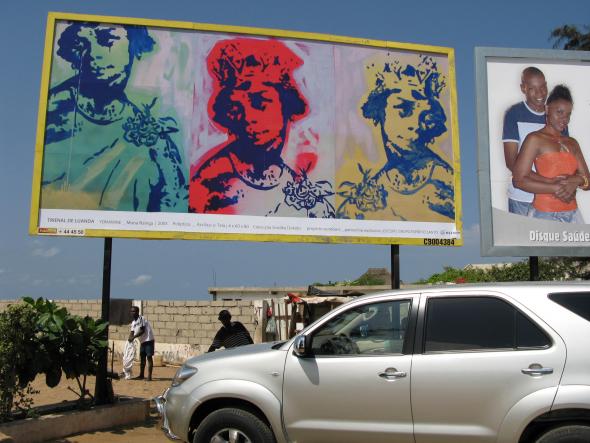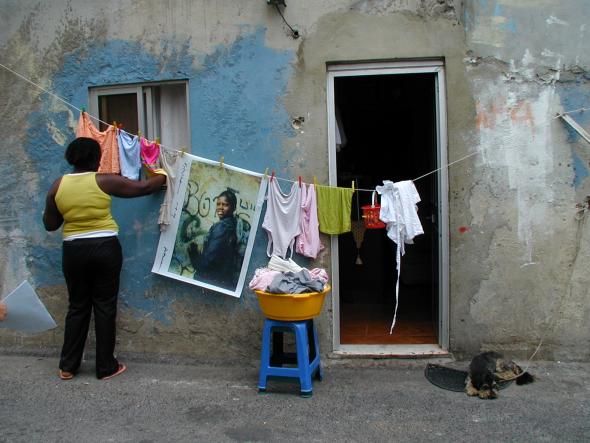Ciudad Sur by Pablo Brugnoli
Thoughts around the interview and conference CIUDAD SUR presented by Pablo Brugnoli, last June 26th on “Próximo Futuro”, Gulbenkian Programme for Contemporary Culture.
According to Pablo Brugnoli, CIUDAD SUR reviews ideas, practices and projects by collectives of architects and artists, whose recent works reinterpret cities from the southern cone of America (Argentina, Brazil, Chile, and Uruguay). The link between them is their focus on the value of communitarian reconstruction, regarding both the procedures and the socio-cultural dynamics. According to his words on the interview, this approach represents “a gesture of disarray regarding the construction of images and landscapes” that currently seems to be the preeminent focus of architects and artists.
What stands out as innovative through the examples shown by Pablo Brugnoli is their common concern on provisional urbanism, as it was named on the project Post it City – Occasional Cities, that studies temporary uses of urban territory, from the diverse points of view of architecture, urbanism and visual arts. It regards an analysis and register of the interaction, connectivity and adaptability of some temporary uses that occur in the cities, resulting from personal or group strategies, with the spontaneous occupation of spaces, once left vague intentionally or accidentally. The potential sprung from the conflicts on these spaces, isn’t viewed as a negative factor that we must necessarily eliminate, but as a sign of possible new situations and as a source that could generate new actions. The intention to consider the unpredictability, the openness to knowledge and the valuation of what occurs is innovative as well, once these factors aren’t usually considered in urban territory management and remain totally invisible in urban planning.
 Yonamine, Trienal de Luanda, 2006.
Yonamine, Trienal de Luanda, 2006.
When Pablo Brugnoli refers to the enormous informal dimension versus the small formal dimension that coexist in Latin American cities, we can distinguish an analogy with some African cities, such as Luanda or Maputo. However, while in Latin American cities, such as São Paulo or Buenos Aires, there are areas where this informality is structural and where we find an established and autonomous power, this doesn’t apply to African cities, where it is evident that the areas that we can also consider informal, though being of spontaneous formation remain in a political and administrative dependency of the formal city.
Between the two, we find in common the occasional use of the informality by the formal power for its convenience. Intermediate stages, neither formal nor informal – which Pablo Brugnoli names as “paraformal”– are thus created, when the formal power “occupies” an informal structure for its benefit. As an example, he spoke about the advantages taken by real estate speculators of the claim of territory for habitation originally held by the piquetero movement, one of the main actors in social struggles in Argentina since the nineties.
In both Latin American and African cities, we could question the continuance of the traditional concept of “urban public space” (centre, square, street), that integrates the concept of city in modernist urbanism, that travelled between Europe, South America and Africa. This concept is still being applied despite the current criticism towards zoning, as an instrument of rationalization of urban space, and towards the idea that a spatial configuration could, by itself, generate sociability, social interactions or even correspond to an expected symbolical significance.
The city growth, often exponential, that increases commuting, the transfer of activities of social reproduction to private places of consumption and also the displacement of social interaction towards the virtual space force us to rethink the future of the traditional urban public space and the growing occupation of land from private space.
Marginal to this discussion between public and private space, in these cities there are “no-men’s lands” – residual spaces left or made empty between places, territories in permanent mutation that are gradually shaped and re-shaped and for which there is no classical categorization. These are interstitial spaces, located in devalued terrains or land of unknown property, areas of economic cleavage, “islands” jammed in the formal city.
These spaces emphasize the fragmentation of the city, and such as peri-urban zones, they are usually invisible to the rest of the city and only noticed when they stage violence. Pablo Brugnoli refers to them when he mentions the difficulties on reading the contemporary city, dominated by the economical/business sector that restrains the information. Brugnoli also underlines the need to observe the different fragments of territory towards a reinterpretation of the city, what he names “to generate archive” – to know what occurs in different cities, such as Santiago, Buenos Aires or São Paulo, creating a connection device of subjectivity, of sensorial experiment and of “estetization”. The archive is, thus, a key for the apprehension of the potential of connection in the context of each city.
 Intervenção de Susan Meiselas, Cova da Moura, 2005, Fotografia de CS.
Intervenção de Susan Meiselas, Cova da Moura, 2005, Fotografia de CS.
Another aspect approached by Pablo Brugnoli is the intervention of artists and architects in the reading and reinterpretation of the city, what he calls an alteration of the point of view: the artist sets his view and the architect tries to make something out of that point of view. It is a way of approaching different languages and confronting different viewpoints, of creating connections without neglecting the creative angle nor the potential of achievement. On this subject, we can recall what Françoise Choay says in her article “Le règne de l’urbain et la mort de la ville” when she refers to the disappearance of the traditional European city. She explains how the converging views of painters, photographers and filmmakers aware us of conventional words, such as historical centre, suburbs or megapolis, and of the concept of city itself.
A disquietude disturbs us and a doubt remains – how can we find answers to urban problems that claim for urgency? How can we step from the reinterpretation of the city into a new way of making city? Pablo Brugnoli states that we are still in an embryonic stage, where every door is still open. He adds that, in this context, urban actions, called micro-urbanisms, may have an important part, and we could compare them with “acupuncture”, in the way we act over a vital point to heal a sick body. In this search for vital points, lays the importance of the experiences related in CIUDAD SUR.